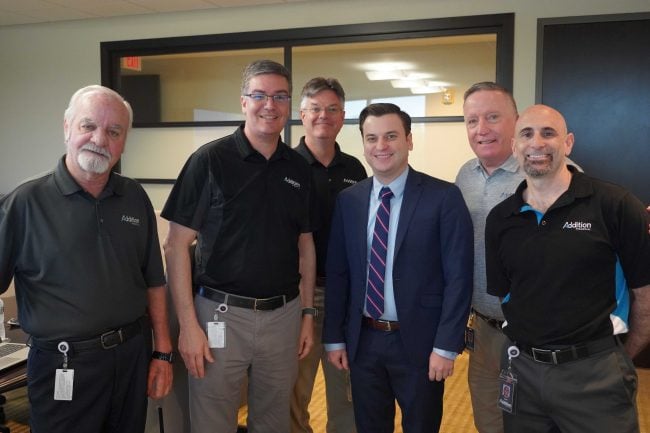 Hayden Hampton, third from right, meets with members of Addition Financial's executive team, including President/CEO Kevin Miller (second from left) and Vice President, Business Intelligence Jason Mizrahi (far right). (Credit/Addition Financial)
Hayden Hampton, third from right, meets with members of Addition Financial's executive team, including President/CEO Kevin Miller (second from left) and Vice President, Business Intelligence Jason Mizrahi (far right). (Credit/Addition Financial)
Addition Financial Credit Union is looking into opening a new branch either slightly north or slightly southwest of its current branch footprint, adding to its network of 26 locations throughout Central Florida. Why those regions in particular? It wasn't an internal research team or third-party service provider that recommended them, but rather a local Ph.D. student.
As the sponsor of an annual analytics competition at the University of Central Florida, the $2.9 billion, Lake Mary, Fla.-based Addition Financial has been challenging students to come up with solutions to business problems year after year, awarding money to the winners and wishing them success in their future careers. But the credit union's leaders were so impressed with the project submitted by this year's winner, Hayden Hampton, that his work is now informing the credit union's decision about where to plant its flag next.
Recommended For You
Addition Financial first partnered with the UCF Department of Statistics and Data Science in 2017 to sponsor the competition, which has taken place every year since except 2020 due to the COVID-19 pandemic. The goal for this year's participants was to "enhance Addition Financial's branch location process to align with changing market dynamics, customer behaviors, and emerging trends in the financial sector"; past years' goals have included solving lending-focused and predictive analytics problems.
Jason Mizrahi, vice president, business intelligence for Addition Financial, said the goal of the sponsorship is two-fold: "One, we want to provide students at UCF with a real-world problem with real data. At the same time, we visit a real problem we are facing in our organization every year, and every year is a different problem. And we're giving the students unfiltered data, so they can see what it's like to really work in this field with the tools you would have at a job."
The latest grand-prize winner began his higher education journey by earning a bachelor's degree in statistics and actuarial science and completing an internship at a reinsurance company. Hampton then obtained a master's degree in statistics and data science, simultaneously completing a second internship with a consulting company. He's now set to complete his Ph.D. in big data analytics at UCF this month.
Upon learning about the 2023-2024 Addition Financial Analytics Competition last year, Hampton said he was particularly interested in entering because the credit union "was posing a highly ambiguous problem that really did not have a clear-cut solution."
"There was a large emphasis on sourcing publicly available information, and while I've done this sort of thing in the past to some extent, I've never done it to the extent that I took this project," he said. "In addition to sourcing data from common places like the Census Bureau, I was looking at lesser-known organizations like government agencies to get information that might not be thought of initially, such as, in the past five years, where were the FDIC-insured bank closures? Where are payday lenders that hold certain licenses located? So I had to look at really esoteric government agencies to actually source this data. So thinking of the type of data that would be useful, and then figuring out how I could actually get it without paying for it, was a really rewarding endeavor."
Mizrahi said unlike in previous years, when participants received millions of records of data from the credit union to work with, Addition Financial provided the 2023-2024 competition's participants with a limited amount of data, including membership and market penetration numbers, leaving them with the challenge of filling in the gaps. "The CEO of our organization on occasion will call me and go, 'Where should we build the next branch?' And that's all he'll say to me, and I figured it would be fun to do the same thing to the students," he said.
Hampton said he worked on the project approximately two to three days per week over a four-month period. He began by measuring the performance of branches in Addition Financial's existing network, determining the credit union's target demographic, and considering factors such as how the presence of competitors influences branch performance, whether tax incentives were available for investing in certain areas and which areas were experiencing growth. He also heavily researched the differences between credit unions and retail banks.
"I discovered that credit unions typically thrive in areas with a high level of social capital and a strong sense of community bond," Hampton said. These included areas close to places of worship, recreation centers, community centers, parks, ice cream parlors and electric vehicle charging stations.
Next, he chose candidate locations in areas without an existing Addition Financial branch and predicted the potential performance of each hypothetical new branch. The result was a recommendation to open a new branch in one of two areas: Slightly southwest of the credit union's existing branch footprint, in between Orlando and Tampa, Fla., and slightly north of its footprint, in between Orlando and Daytona Beach, Fla.
 Screenshot of Addition Financial's current branch locations. (Credit/additionfi.com)
Screenshot of Addition Financial's current branch locations. (Credit/additionfi.com) In the final stage of the competition, Hampton presented a technical written brief, which summarized all the work he had done, before a panel of judges from Addition Financial at the credit union's headquarters. Addition Financial also tested all of Hampton's code associated with the project to ensure its quality and that it could be used repeatedly over time.
According to Mizrahi, judges were especially impressed with the level of research he conducted on credit unions, as well as the fact that he completed the project on his own. While the competition's participants are typically advised to collaborate with other students with experience in business, public speaking and writing, Hayden brought all of these skills to the table himself, he said.
"Some of the feedback I gave him after the competition was, 'It was almost like you worked here and knew how we operate when attacking a problem like this,'" Mizrahi said.
 Hayden Hampton, fourth from left, receives his grand-prize check from Addition Financial Business Intelligence department team members (from left to right) Jason Mizrahi, Kyle Parcels, Tristan Couple, Lauren Solivan, Sital Nayee and Kristen Karlen at UCF's Big Data Analytics Symposium. (Credit/Addition Financial)
Hayden Hampton, fourth from left, receives his grand-prize check from Addition Financial Business Intelligence department team members (from left to right) Jason Mizrahi, Kyle Parcels, Tristan Couple, Lauren Solivan, Sital Nayee and Kristen Karlen at UCF's Big Data Analytics Symposium. (Credit/Addition Financial) Addition Financial announced Hampton as the competition's winner at UCF's Big Data Analytics Symposium, held this year on the university's main campus in Orlando on March 14. Hampton's prize was a check for $3,000, and participants who placed second and third received $1,000 each.
Hampton was clued into the fact that he had won prior to the symposium, however. Shortly before the formal event, he was invited back to Addition Financial's headquarters to give his presentation again, this time in front of credit union C-suite executives, including President/CEO Kevin Miller. That was when a conversation about bringing his strategy into the credit union's real-world site location selection process began.
Mizrahi explained that Addition Financial's branch location selection process has evolved from a remedial one – one that typically involved looking at a map and determining where the population was growing, and where the credit union wanted to grow – to an analysis-based one that is similar to the process Hampton developed. However, Hampton took it a step further.
"He went as far as to say, when you see a cluster of places like churches, that's typically where credit unions want to be because these are the places the people who bank with credit unions visit on a frequent occasion," Mizrahi said. "We have done a similar analysis, but we looked at things like supermarkets, hardware stores, places that are weekend destination locations. He was able to put more context around it and data behind it, which allows us a larger opportunity zone to say, this may not be near a supermarket, but it's really our bread and butter credit union location, and maybe we should be looking at that."
What does the future hold for Hampton's relationship with Addition Financial? Mizrahi said the lines of communication between the two parties will remain open as scouting for the next branch occurs, and that there have been some internal discussions about giving Hampton other projects to work on.
And for Hampton, the project resulted in an unexpected potential plan for his future: To work within the credit union industry.
"I found that the overarching philosophy [of credit unions] actually aligns really well with my own personal beliefs," Hampton said. "So I'm definitely interested in the credit union industry potentially, if things work out. But the financial industry generally is definitely where I'm headed."
© Touchpoint Markets, All Rights Reserved. Request academic re-use from www.copyright.com. All other uses, submit a request to [email protected]. For more inforrmation visit Asset & Logo Licensing.







